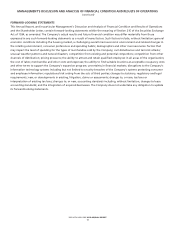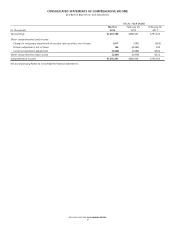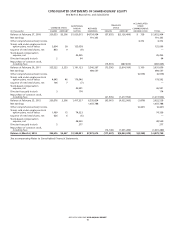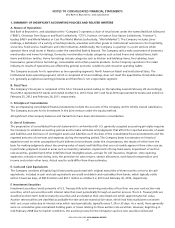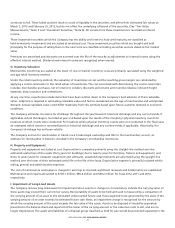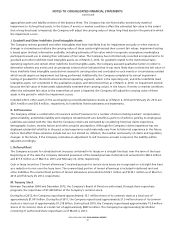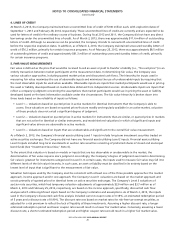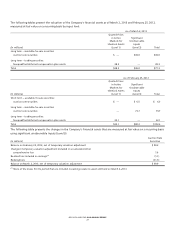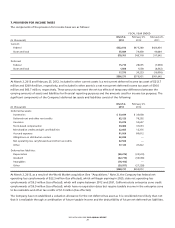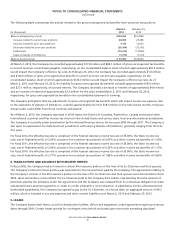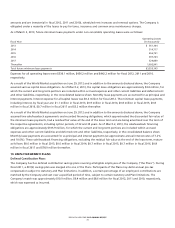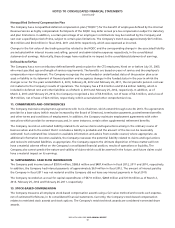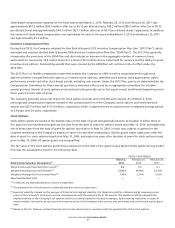Bed, Bath and Beyond 2012 Annual Report Download - page 26
Download and view the complete annual report
Please find page 26 of the 2012 Bed, Bath and Beyond annual report below. You can navigate through the pages in the report by either clicking on the pages listed below, or by using the keyword search tool below to find specific information within the annual report.previously granted awards that remained unvested at the date of adoption. Currently, the Company’s stock-based
compensation relates to restricted stock awards and stock options. The Company’s restricted stock awards are considered
nonvested share awards.
U. Income Taxes
The Company files a consolidated Federal income tax return. Income tax returns are also filed with each taxable jurisdiction in
which the Company conducts business.
The Company accounts for its income taxes using the asset and liability method. Deferred tax assets and liabilities are
recognized for the future tax consequences attributable to the differences between the financial statement carrying amounts
of existing assets and liabilities and their respective tax bases and operating loss and tax credit carry-forwards. Deferred tax
assets and liabilities are measured using enacted tax rates expected to apply to taxable income in the year in which those
temporary differences are expected to be recovered or settled. The effect on deferred tax assets and liabilities of a change in
tax rates is recognized in earnings in the period that includes the enactment date.
The Company intends to reinvest the unremitted earnings of its Canadian subsidiary. Accordingly, no provision has been made
for U.S. or additional non-U.S. taxes with respect to these earnings. In the event of repatriation to the U.S., in most cases such
earnings would be subject to U.S. income taxes.
The Company recognizes the tax benefit from an uncertain tax position only if it is at least more likely than not that the tax
position will be sustained on examination by the taxing authorities, based on the technical merits of the position. The tax
benefits recognized in the financial statements from such a position are measured based on the largest benefit that has a
greater than fifty percent likelihood of being realized upon settlement with the taxing authorities.
Judgment is required in determining the provision for income taxes and related accruals, deferred tax assets and liabilities. In
the ordinary course of business, there are transactions and calculations where the ultimate tax outcome is uncertain.
Additionally, the Company’s tax returns are subject to audit by various tax authorities. Although the Company believes that its
estimates are reasonable, actual results could differ from these estimates.
V. Earnings per Share
The Company presents earnings per share on a basic and diluted basis. Basic earnings per share has been computed by dividing
net earnings by the weighted average number of shares outstanding. Diluted earnings per share has been computed by
dividing net earnings by the weighted average number of shares outstanding including the dilutive effect of stock-based
awards as calculated under the treasury stock method.
Stock-based awards of approximately 1.2 million, 0.9 million and 1.5 million shares were excluded from the computation of
diluted earnings per share as the effect would be anti-dilutive for fiscal 2012, 2011 and 2010, respectively.
W. Recent Accounting Pronouncements
In September 2011, the Financial Accounting Standards Board (‘‘FASB’’) issued updated accounting guidance related to testing
goodwill for impairment. This guidance permits an entity to first assess qualitative factors to determine whether it is more
likely than not that the fair value of a reporting unit is less than its carrying value as a basis for determining whether it is
necessary to perform the two-step goodwill impairment test. This guidance is effective for annual and interim goodwill
impairment tests performed for fiscal years beginning after December 15, 2011. During the fourth quarter of fiscal 2012, the
Company adopted this guidance. The adoption of this guidance did not have a material impact on the Company’s consolidated
financial statements.
In July 2012, the FASB issued updated accounting guidance related to testing indefinite lived intangible assets for impairment.
This guidance permits an entity to first assess qualitative factors to determine whether the existence of events and
circumstances indicates that it is more likely than not that the fair value of an indefinite lived intangible asset is less than its
carrying amount as a basis for determining whether it is necessary to perform the annual impairment analysis. This guidance is
effective for annual and interim indefinite lived intangible asset impairment tests performed for fiscal years beginning after
September 15, 2012. Early adoption is permitted. During the fourth quarter of fiscal 2012, the Company adopted this
guidance. The adoption of this guidance did not have a material impact on the Company’s consolidated financial statements.
NOTES TO CONSOLIDATED FINANCIAL STATEMENTS
(continued)
BED BATH & BEYOND 2012 ANNUAL REPORT
24


